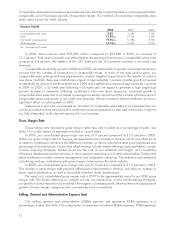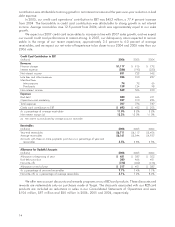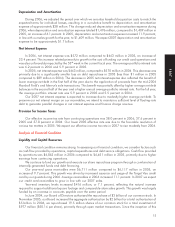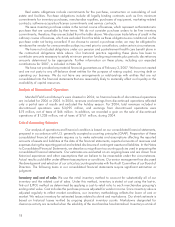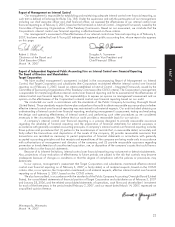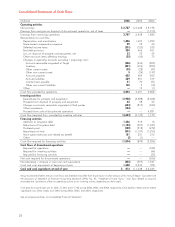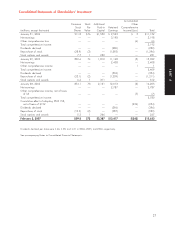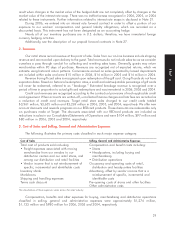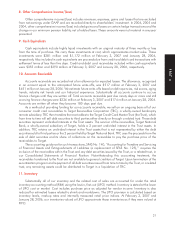Target 2006 Annual Report Download - page 39
Download and view the complete annual report
Please find page 39 of the 2006 Target annual report below. You can navigate through the pages in the report by either clicking on the pages listed below, or by using the keyword search tool below to find specific information within the annual report.
Forward-Looking Statements
This report, including the preceding Management’s Discussion and Analysis, contains forward-looking
statements regarding our performance, financial position, liquidity and adequacy of capital resources.
Forward-looking statements are typically accompanied by the words ‘‘expect,’’ ‘‘may,’’ ‘‘could,’’
‘‘believe,’’ ‘‘would,’’ ‘‘might,’’ ‘‘anticipates,’’ or words of similar import. The forward-looking statements in
this report include the anticipated impact of new and proposed accounting pronouncements, the expected
outcome of pending and threatened litigation, our expectations with respect to our share repurchase
program and our outlook in fiscal 2007. Forward-looking statements are based on our current assumptions
and expectations and are subject to certain risks and uncertainties that could cause actual results to differ
materially from those projected. We caution that the forward-looking statements are qualified by the risks
and challenges posed by increased competition (including the effects of competitor liquidation activities),
shifting consumer demand, changing consumer credit markets, changing wages, health care and other
benefit costs, shifting capital markets and general economic conditions, hiring and retaining effective team
members, sourcing merchandise from domestic and international vendors, investing in new business
strategies, the outbreak of war or pandemics and other significant national and international events, and
other risks and uncertainties. As a result, although we believe there is a reasonable basis for the forward-
looking statements, you should not place undue reliance on those statements. You are encouraged to
review Exhibit (99)A to this Form 10-K, which contains additional important factors that may cause actual
results to differ materially from those predicted in the forward-looking statements.
Item 7A. Quantitative and Qualitative Disclosures About Market Risk.
Our exposure to market risk results primarily from interest rate changes on our debt obligations and on
our credit card receivables, the majority of which are now assessed finance charges at a prime-based
floating rate. To preserve our net interest margin, we intend to maintain sufficient levels of floating-rate debt
to generate parallel changes in net interest expense as finance charge revenues fluctuate. At February 3,
2007, our level of floating-rate debt obligations exceeded our level of floating-rate credit card assets by
approximately $1 billion. As a result, based on our balance sheet position at February 3, 2007, the
annualized effect of a one percentage point increase in floating interest rates on our interest rate swap
agreements and other floating rate debt obligations, net of our floating rate credit card assets, would be to
decrease earnings from continuing operations before income taxes by approximately $10 million. See
further description in Note 21.
We record our general liability and workers’ compensation liabilities at net present value; therefore,
these liabilities fluctuate with changes in interest rates. We economically hedge a portion of our exposure to
these interest rate changes by entering into interest rate forward contracts that partially mitigate the effects of
interest rate changes. As a result, we do not have significant net exposure to interest rate changes for these
liabilities.
In addition, we are exposed to fluctuations of market returns on our qualified defined benefit pension
and nonqualified defined contribution plans. The annualized effect of a one percentage point decrease in
the return on pension plan assets would decrease plan assets by $21 million at February 3, 2007. The
resulting impact on net pension expense would be calculated consistent with the provisions of SFAS No. 87,
‘‘Employers’ Accounting for Pensions.’’ See further description in Note 28.
As more fully described in Note 14 and Note 27, we are exposed to market returns on accumulated
team member balances in our nonqualified, unfunded deferred compensation plans. We control our risk of
offering the nonqualified plans by making investments in life insurance contracts and prepaid forward
contracts on our own common stock that offset a substantial portion of our economic exposure to the returns
on these plans. The annualized effect of a one percentage point change in market returns on our
nonqualified defined contribution plans (inclusive of the effect of the investment vehicles used to manage
our economic exposure) would not be significant.
We do not have significant direct exposure to foreign currency rates as all of our stores are located in
the United States and the vast majority of imported merchandise is purchased in U.S. dollars.
Overall, there have been no material changes in our primary risk exposures or management of market
risks since the prior year.
21
PART II



